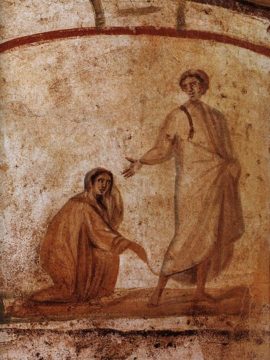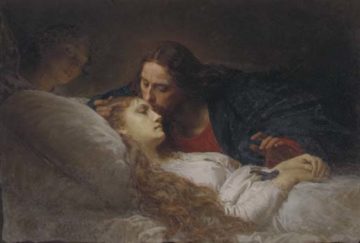As we anticipate the Thirteenth Sunday of Ordinary Time 2021, Fr. Paul Gallagher, OFM offers a Scriptural Reflection. This content is edited by Franciscan Sister of Christian Charity Sister Anne Marie Lom and Joe Thiel. The excerpts from the Sunday readings are prepared by Joe Thiel. To read or download the complete pdf with excerpts for your prayer, please click here: Franciscan Gospel Reflection June 27 2021 . Excerpts are from the Lectionary for Mass for Use in the Dioceses of the United States of America, second typical edition © 2001, 1998, 1997, 1986, 1970 Confraternity of Christian Doctrine, Inc., Washington, DC. Used with permission. All rights reserved. No portion of this text may be reproduced by any means without permission in writing from the copyright owner. Image: By Ernesto Fontana – https://www.invaluable.com/auction-lot/ernesto-fontana-italian,-1837-1918-56-c-qvi4e8cl2i, Public Domain, https://commons.wikimedia.org/w/index.php?curid=31226140
Mark 5:21-43
When Jesus had crossed again in the boat to the other side, a large crowd gathered around him, and he stayed close to the sea. One of the synagogue officials, named Jairus, came forward. Seeing him he fell at his feet and pleaded earnestly with him, saying, “My daughter is at the point of death. Please, come lay your hands on her that she may get well and live.” He went off with him, and a large crowd followed him and pressed upon him.
 There was a woman afflicted with hemorrhages for twelve years. She had suffered greatly at the hands of many doctors and had spent all that she had. Yet she was not helped but only grew worse. She had heard about Jesus and came up behind him in the crowd and touched his cloak. She said, “If I but touch his clothes, I shall be cured.” Immediately her flow of blood dried up. She felt in her body that she was healed of her affliction. Jesus, aware at once that power had gone out from him, turned around in the crowd and asked, “Who has touched my clothes?” But his disciples said to him, “You see how the crowd is pressing upon you, and yet you ask, ‘Who touched me?'” And he looked around to see who had done it. The woman, realizing what had happened to her, approached in fear and trembling. She fell down before Jesus and told him the whole truth. He said to her, “Daughter, your faith has saved you. Go in peace and be cured of your affliction.”
There was a woman afflicted with hemorrhages for twelve years. She had suffered greatly at the hands of many doctors and had spent all that she had. Yet she was not helped but only grew worse. She had heard about Jesus and came up behind him in the crowd and touched his cloak. She said, “If I but touch his clothes, I shall be cured.” Immediately her flow of blood dried up. She felt in her body that she was healed of her affliction. Jesus, aware at once that power had gone out from him, turned around in the crowd and asked, “Who has touched my clothes?” But his disciples said to him, “You see how the crowd is pressing upon you, and yet you ask, ‘Who touched me?'” And he looked around to see who had done it. The woman, realizing what had happened to her, approached in fear and trembling. She fell down before Jesus and told him the whole truth. He said to her, “Daughter, your faith has saved you. Go in peace and be cured of your affliction.”
While he was still speaking, people from the synagogue official’s house arrived and said, “Your daughter has died; why trouble the teacher any longer?” Disregarding the message that was reported, Jesus said to the synagogue official, “Do not be afraid; just have faith.” He did not allow anyone to accompany him inside except Peter, James, and John, the brother of James. When they arrived at the house of the synagogue official, he caught sight of a commotion, people weeping and wailing loudly. So he went in and said to them, “Why this commotion and weeping? The child is not dead but asleep.” And they ridiculed him. Then he put them all out. He took along the child’s father and mother and those who were with him and entered the room where the child was. He took the child by the hand and said to her, “Talitha koum,” which means, “Little girl, I say to you, arise!” The girl, a child of twelve, arose immediately and walked around. At that they were utterly astounded. He gave strict orders that no one should know this and said that she should be given something to eat.
Background:
Some scripture scholars believe that Mark has deliberately linked the cure of these two women together so that together their significance will become more apparent. The similarities and the differences in the two stories are significant.
Both cures involve women who have lost their value in their community. The older woman is not able to conceive because of her irregular menstruation cycle, and the young daughter is not healthy enough. Both are ritually unclean, and any person having contact with either woman would also be made ritually unclean. They both have “twelve” in their story: the woman has been dealing with her illness for twelve years, and the girl is twelve years of age. In both cases it is the touch, the contact with Jesus, which brings healing to each of them, even while in both cases it jeopardizes Jesus’ ritual purity. Jesus not only heals both of them, but also restores them to their place in the community. With the woman, this is symbolized by Jesus calling her “daughter” and acknowledging that she is both cured and saved. With Jairus’ daughter, Jesus tells her parents to give her something to eat. In this culture, eating together always implies the establishment and recognition of a relationship.
There are also some notable differences in the two accounts. Jairus, the synagogue official, is named by Mark. He approaches Jesus openly in public and makes his request known. The woman who suffers with an irregular menstruation cycle is not named. She approaches Jesus covertly and touches his garment, violating social and religious protocols. She is a woman, and ritually unclean, but she is cured. This is the only place in the gospels where Jesus does not initiate the healing. Instead, the one afflicted reaches out, and of her own belief touches the power of God present in the person of Jesus. Jesus’ response is also significant. He alone, at first, is aware that something unusual has happened, that power has gone out of him. To the astonishment of the crowd and the disciples, he seeks out the person. He acknowledges not only the cure, but also the woman’s faith. Nonetheless, Jesus calls her “daughter,” and he tells her to go in peace.
Reflection Questions:
- Recall some times when you have acted in desperation. What do you remember about those situations?
- Have people ever come to you in desperation? What were some of the thoughts and feelings going through you in those situations?
- When you are ill, are you more likely to endure quietly or to seek assistance?
- If can imagine yourself among the disciples, what would you have replied when Jesus asked, “Who touched me?”
- If you were present when the people arrived telling Jairus not to bother the teacher further, because his daughter had died, you might have said something like…
- Can you take some time to talk with God about how you are feeling as you consider this text, or as you consider people in your own community who are living in desperate situations, or how you feel now about the times when you have turned to God in desperate times?




Article Comments:
Fr. Placid Stroik, OFM 06/24/2021 @ 6:36 pm
In desparate moments, after “now what?” And our Lady of Good Help, pray for us~! It is a cry for who can help me? and what is mine to do… and welcoming my disappointment, I reach out with a cry: “who can help me? and I allow someone to help me”.
Recently it was three, not one “Good Samaritan” “on the road” who reached down, felt my pain, and helped me with a flat tire.
then shortly after that it was medical staff who reached down, felt my pain and helped me with a stomach digestive concern.
These “good samaritans” (Jesus) in their own words said: “Talitha koum” and I did arise. thank you. Peace and all good.